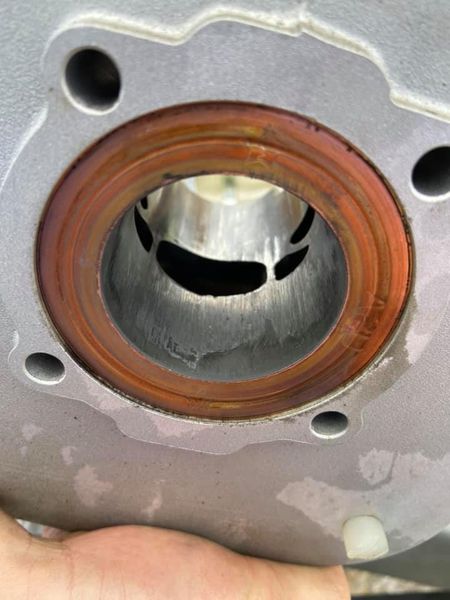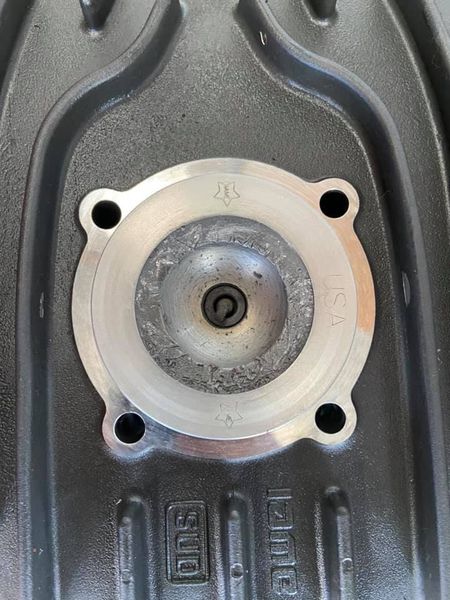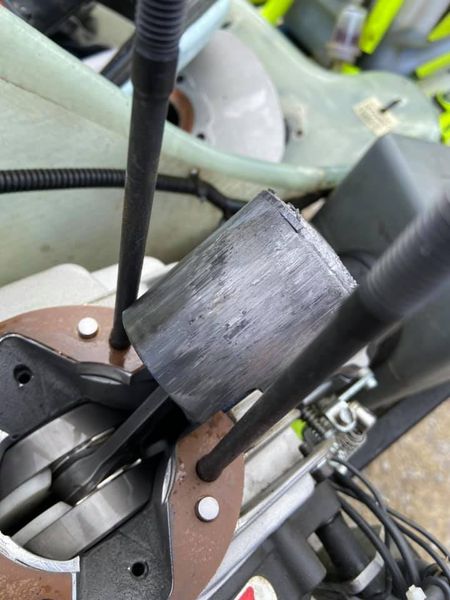They make one, but as stated they have to turn down the starter nut to clear the chain. I think I will give it a try. My other option I think is to move to a 10* mount to help clear the top side of the chain.
The 9 tooth drive sprocket for the KA may not be legal to run, depending on your regulations, as it is not an “IAME part”.
Also there is no room for a roller bearing on a 9 tooth, so I believe it has a bushing to let it spin with the clutch.
I’ve seen them for sale, and am usually running an 80 - 85 tooth sprocket so I would like to have a smaller front, but have been turned off by what I’ve heard about the 9 tooth sprocket seizing onto the shaft.
Looking for information on CHT for the KA100 and have not been able to find it. Does anyone have recommendation or ranges of cylinder head temps for the KA?
If anyone wants a 9T front driver cheaper than retail I have one that I literally ran for 4 laps at Whiteland and then pulled off because the motor was turning too many RPM.
As stated it uses a brass bushing that rides on the crank like KT100 clutches used to use as the roller bearing will not fit with the smaller diameter gear. You do also need the special cut down nut to clear the chain, most shops are just cutting the OEM nut in a lathe to create the necessary clearance.
I didn’t find it very useful in my application, others that run that same track state they are turning their best times running the 9T driver and spinning the engine to 17k, went back to the 10T and turned like 16,200 and won our race that day.
Zach, I’ve considered a math channel to help with gearing as well. I think it likely needs to be a couple channels.
I agree with Tony that what we need is a histogram to show the RPM range where the most time is spent. Ideally if you’re spending more time in peak power around the track then you should be faster. Of course that has to be weighed against time spent outside of the peak power range.
It’s funny that the 9 tooth is so rare irl. It’s my go to front sprocket in KK for x30. Nice to know about it’s weirdness IRL.
I agree. I think the one I’ve been using is a building block but not the complete solution. Unfortunately I’m not smart enough to come up with the math channels themselves ha. I’m just trying to spark an idea to hopefully get to something usable.
I did try the lower gearing and left it on all day Saturday. As expected, I picked up a ton on top end. Unfortunately I was driving less than superb and was losing time in two key corners which was only exaggerated with the lower gearing. It’s a bit ironic that I talked about being consistent and then I was the opposite  . I was over charging entry and then couldn’t get back to throttle soon enough to make use of the lower gearing. Time wise I was semi close to the front runners but I easily had another 0.3-0.4 worth of loss in two corners because of my own doing.
. I was over charging entry and then couldn’t get back to throttle soon enough to make use of the lower gearing. Time wise I was semi close to the front runners but I easily had another 0.3-0.4 worth of loss in two corners because of my own doing.
Back to KA talk. My motor has right around 5hours on it. I did a carb kit at 4hrs. What else should I look into over the winter?
Technically nothing at 5 hours, but it depends on how hard you are on it and how many hours you intend on putting on it next year. I tried to go over 10 hours on top end this year and paid the price when I broke a piston and caused even more damage and had to buy a new cylinder on top of everything else. My builder recommends 6-10 hours on top ends depending on how hard you spin it, how on the edge of dangerous your EGT’s are, etc.
…so it’s early for a top end but if you intend to go more than 5 hours in the spring when you get it out then maybe get it done now in the off season instead of in the middle of a race season next year.
A smaller drive gear can be helpful in situations where your rear sprocket is in danger of hitting kerbs etc.
For example, you could use 9:80 vs 10:88
Typically, most tuning would be done off EGT and not CHT. I run both, but find myself only looking at CHT if the motor is running like crap and the EGT numbers look good. I find the CHT on our KA is usually somewhere between 270-290 degrees. You get any higher than that and it gets slower and runs like crap.
Thanks Michael,
My son is starting to run KA and I haven’t converted it to EGT so I was looking for some numbers for CHT. That number is interesting as it is around 100* less than Yamaha. As I recall you are running the junior header, does that change the temps at all?
Thanks for the info.
The Junior header doesn’t add any extra temp to the motor.
Best bet is to get it converted to EGT because you won’t be able to tune it based on CHT. The air temperature will have an affect on the CHT as well.
3 of us decided to take a late year trip to Tulsa OK to run our KA100s.
This is what happened to a buddies KA, we are pretty sure his EGT sensor went bad so he kept leaning it down, as he was having problems getting over 900, then it popped. He didnt get over 15k for the weekend. I was running 16-16.2k rpms.
We were all running fuel from the same jug, 110 with 38oz of redline to 5 gallons.
He left it with a local to drop off at Woltjer for rebuild and blue print. I am scared to see what the bill on this one is going to be.

“Blue printing” is not supposed to be required for KA100 and is “illegal/ frowned upon” here in Australia.
If the bottom end is still fine the parts to fix should only cost around $200 Aus. The rest is Labour, which for someone setup to do it, should take around an hour.
The average hourly rate in Automotive land (in Aust.) is around $100 an hour
So anything over $300-$400 is too much IMO.
If the main bearings are gone and they have to split the case add another hour and $150 for parts.
If the Crank has to be split all bets are off- the pin, bearing and rod are $600 plus another hour or so.
It will be interesting to see what it costs.
9/79 = 8.78
9/80 = 8.89
10/88 = 8.80
I think most of the “blue printing” that happens in the US is around adjusting the gaskets to change the timing, and then dyno break-in and tuning. With the motor being a single cylinder, and all parts having to be stock OEM parts, “blue printing” of a kart motor is not what it is for other race motors. I remember when my dad was involved in tunnel race boats, when he would build the motors, he would weigh all the parts and match them to each powerplant. Along with making sure all the tolerances were to exact specs.
Besides the top end and possibly the bottom, have the carb gone through as well. Any idea of the needle settings when it stuck?
Verify the EGT sensor with boiling water.
We left his whole motor package there. I want to say he was at like 70 mins on the low and 55 on the high. Might have been closer to 50 on the high.
We checked pop off before going out in the first session it was right at 9.5
That’s a mechanical failure from looks of it vs wrong jetting. I wonder if it’s a piston pin failure, that would explain a lack of performance too.
Whatever it was snagged the exhaust port good too.
Assuming 900 F (900 C would be 1652 F) I would have gone richer 1st to test for too lean. My KT100 ran best at about 1200 F. Of course it had a bigger combustion chamber. When you go too lean, the EGT Will read lower Because of detonation. Some other things should be clarified such as the position of the EGT probe, both distance from the piston and position of the tip of the probe.


